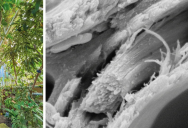New Study Finds That Tulip Trees Not Only Have A Unique Type Of Wood, But Can Also Capture More Carbon Than Previously Known

In a perfect world, we would be able to transition away from producing greenhouse gasses and other things that harm the environment, but that is not likely to happen anytime soon.
In addition to continued efforts in that direction, finding ways to capture the carbon produced is the next best thing.
There are many different efforts that various companies and governments are working on to help capture carbon that is already in the environment, but it typically takes quite a bit of effort.
A study that has been published in the journal New Phytologist, however, there may be a way to capture significant amounts of carbon by simply growing tulip trees.

Tulip trees (which don’t actually grow tulips) were looked at by Dr. Jan Lyczakowski of Jagiellonian University using a low temperature scanning electron microscope.
This allowed them to study its structure in its natural state. What they found was surprising. Dr. Lyczakowski commented on it in a statement:
“We show Liriodendrons have an intermediate macrofibril structure that is significantly different from the structure of either softwood or hardwood. Liriodendrons diverged from Magnolia Trees around 30-50 million years ago, which coincided with a rapid reduction in atmospheric CO2. This might help explain why Tulip Trees are highly effective at carbon storage.”
The structure of these trees is different from either hardwood or softwood trees, making them in a category of their own. These trees grow faster than hardwood varieties and are able to capture carbon from the surrounding environment as it grows.
While this has the potential to provide important carbon containment in the immediate future, it is not a long term solution.
When the trees die, or are burned, that carbon will be released back into the environment. Having this as an option to reduce the presence of the greenhouse gas in the short term while additional green efforts are made to reduce the production of them in the future.
Growing trees can help to buy time with carbon capture.
Thought that was fascinating? Here’s another story you might like: Why You’ll Never See A Great White Shark In An Aquarium

Sign up to get our BEST stories of the week straight to your inbox.




